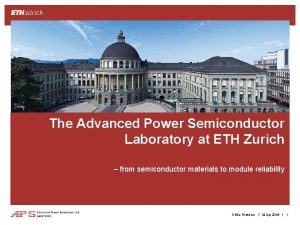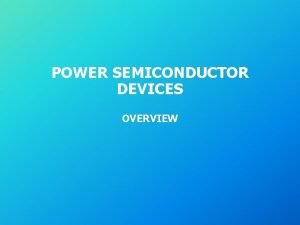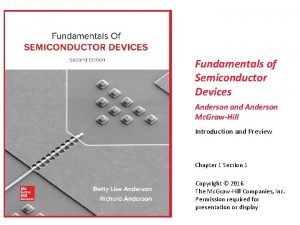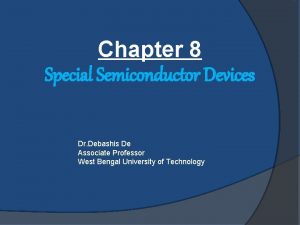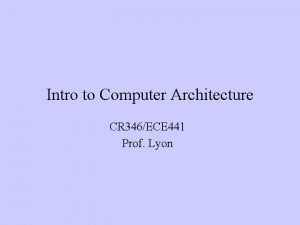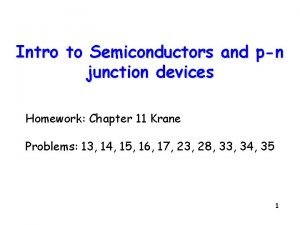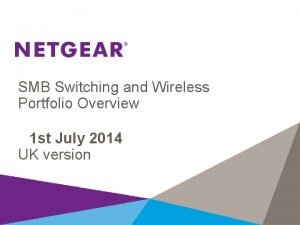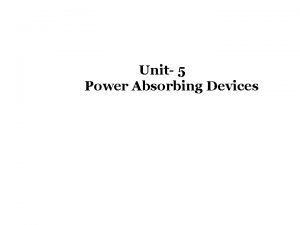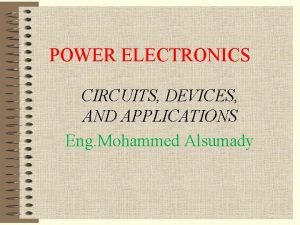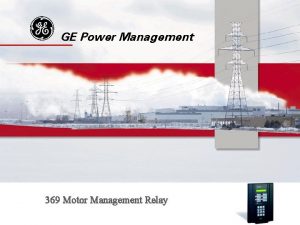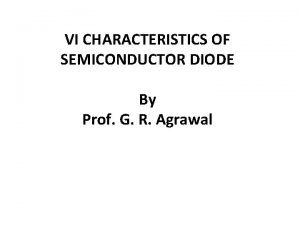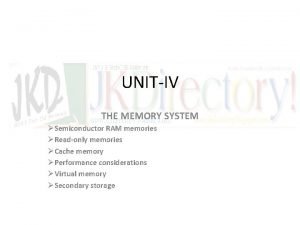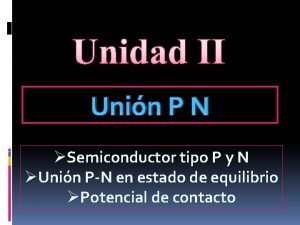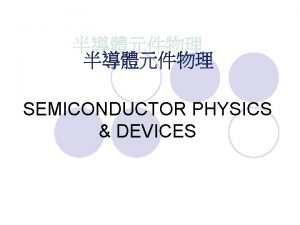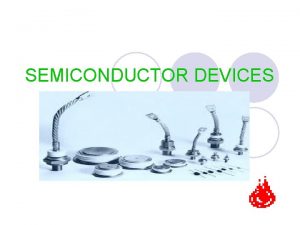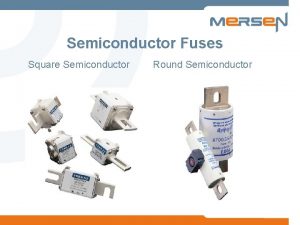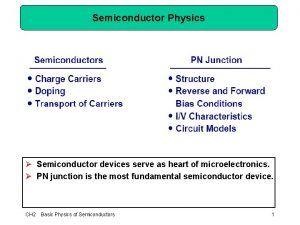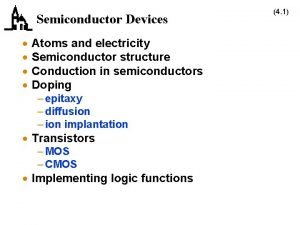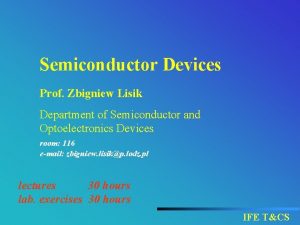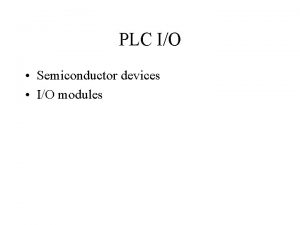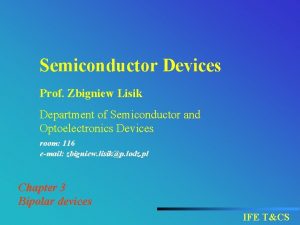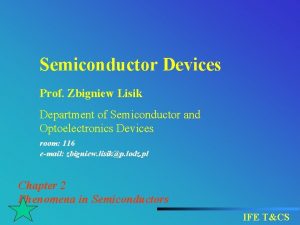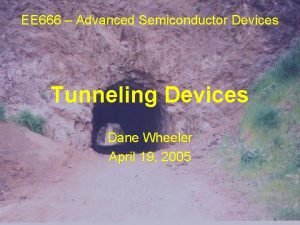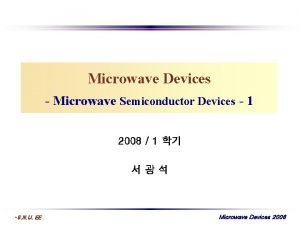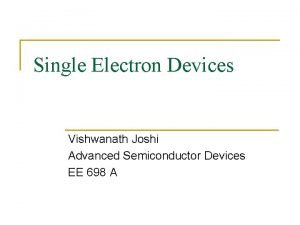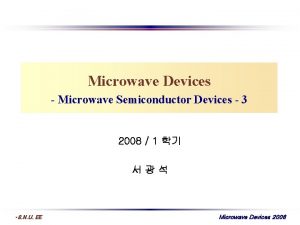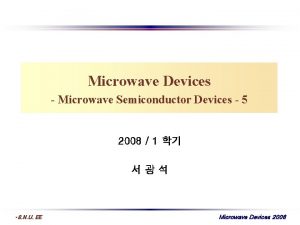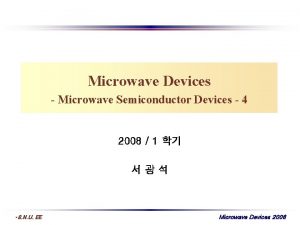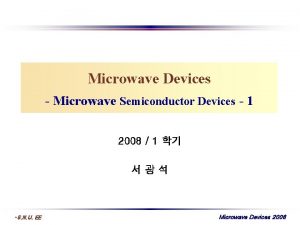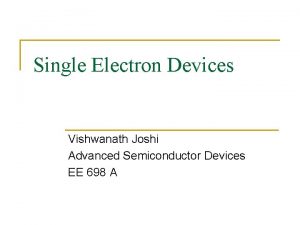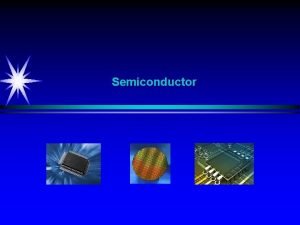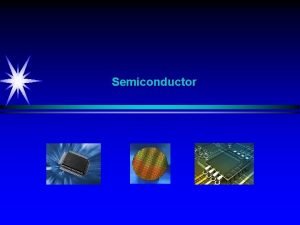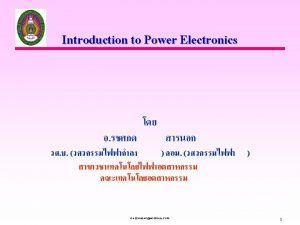POWER SEMICONDUCTOR DEVICES OVERVIEW Historical n n 1


























- Slides: 26

POWER SEMICONDUCTOR DEVICES OVERVIEW

Historical n n 1 st thyristor SCR developed in 1957 Since 1970, various type of power electronic devices were developed and become commercially available.

Power semiconductor Devices Classification n Classification by materials (carrier type)

n n The two-terminal devices (diodes), whose state is completely dependent on the external power circuit they are connected to; The three-terminal devices, whose state is not only dependent on their external power circuit, but also on the signal on their driving terminal (gate or base). Transistors and thyristors belong to that category. A second classification is less obvious, but has a strong influence on device performance: Some devices are majority carrier devices (Schottky diode, MOSFET), while the others are minority carrier devices (Thyristor, bipolar transistor, IGBT). The former use only one type of charge carriers, while the latter use both (i. e electrons and holes). The majority carrier devices are faster, but the charge injection of minority carrier devices allows for better On-state performance

Common power devices n Some common power devices are the power diode, thyristor, power MOSFET and IGBT. A power diode or MOSFET operates on similar principles to its low-power counterpart, but is able to carry a larger amount of current and typically is able to support a larger reversebias voltage in the off-state. Structural changes are often made in power devices to accommodate the higher current density, higher power dissipation and higher reverse breakdown voltage. The vast majority of the discrete (non integrated) power devices are built using a vertical structure, whereas small-signal devices employ a lateral structure. With the vertical structure, the current rating of the device is proportional to its area, and the voltage blocking capability is achieved in the height of the die. With this structure, one of the connections of the device is located on the bottom of the semiconductor die SCR / Thyristor module 6500 V, 1, 500 A for 50 us pulse

Power semiconductor Devices Classification by control method

Power semiconductor Devices Classification by operation (direction of current flow)

The Ideal Switch - The Power Electronics Engineer's Dream zero leakage current ð support infinite voltage zero forward voltage drop ð zero conduction loss instantaneous switching ð zero switching loss zero thermal resistance ð infinite temperature capability infinite current capability

The Ideal Switch - The Power Electronics Engineer's Dream (Cont. . ) An impossible dream but advances in device and packaging technology have produced • conductivity modulated bipolar devices for high power applications at high temperatures • mosfet fabrication for high frequency switching

Generic Switch Symbol • Idealized switch symbol • When on, current can flow only in the direction of the arrow • Instantaneous switching from one state to the other • Zero voltage drop in on-state • Infinite voltage and current handling capabilities

Characteristics of Practical Devices Switching Power Loss is proportional to: • switching frequency • turn-on and turn-off times

POWER SEMICONDUCTOR DEVICES n n n Power Diode Thyristors (11 types) Transistors n n Power Bipolar Junction Transistor (BJTs) Power Metal Oxide Semiconductor field-effect transistors (MOSFETs) Insulated-gate bipolar transistor (IGBTs) Static Induction Transistors (SITs)

Power Diode n On and off states controlled by the power circuit n An ideal diode should have the following characteristics: When forward-biased, the voltage across the end terminals of the diode should be zero, whatever the current that flows through it (on-state); When reverse-biased, the leakage current should be zero, whatever the voltage (off-state). The transition between on and off states should be instantaneous 1. 2. 3.

Types of diode n Shottky diodes. n n n Fast-recovery diodes. n n n Use where a low forward voltage drop is needed in very low output voltage circuit. blocking voltage capability to 50 -100 V. Used in high f circuit in combination with controllable switches, small recovery time. At several hundred V and I, trr <μs Line-frequency diodes. n n n On-state voltage is low as possible and as a sequence have larger trr which are acceptable for line-freq application. Blocking voltage=several k. V, I rating=several k. A Series and parallel for satisfy the requirement.

Power Diode Turn-Off n Fast-recovery diodes have a small reverse-recovery time

Thyristors • Semi-controlled device • Latches ON by a gate-current pulse if forward biased • Turns-off if current tries to reverse

Thyristor in a Simple Circuit • For successful turn-off, reverse voltage required for an interval greater than the turn-off interval

Bipolar Junction Transistors (BJT) • Used commonly in the past • Now used in specific applications • Replaced by MOSFETs and IGBTs

Various Configurations of BJTs

MOSFETs • Easy to control by the gate • Optimal for low-voltage operation at high switching frequencies • On-state resistance a concern at higher voltage ratings

Gate-Turn-Off Thyristors (GTO) • Slow switching speeds • Used at very high power levels • Require elaborate gate control circuitry

GTO Turn-Off • Need a turn-off snubber

IGBT

MCT

Comparison of Controllable Switches

Summary of Device Capabilities
 Power semiconductor devices
Power semiconductor devices Classification of power semiconductor devices
Classification of power semiconductor devices Power semiconductor devices lecture notes
Power semiconductor devices lecture notes Fundamentals of semiconductor devices anderson solution
Fundamentals of semiconductor devices anderson solution Special semiconductor devices
Special semiconductor devices Semiconductor devices
Semiconductor devices Semiconductor junction devices
Semiconductor junction devices Power triangle formula
Power triangle formula Client devices portfolio overview
Client devices portfolio overview What are literary elements
What are literary elements What are input devices and output devices
What are input devices and output devices Which of these is a power absorbing device
Which of these is a power absorbing device Power electronics circuits devices and applications
Power electronics circuits devices and applications Ge power management devices
Ge power management devices Solar power satellites and microwave power transmission
Solar power satellites and microwave power transmission Actual power
Actual power Flex power power supply
Flex power power supply The dispersive power of a grating is defined as the :
The dispersive power of a grating is defined as the : Power of a power property
Power of a power property Chain rule範例
Chain rule範例 Power angle curve in power system stability
Power angle curve in power system stability Power bi power point
Power bi power point Power delivered vs power absorbed
Power delivered vs power absorbed Tunnel diode v-i characteristics
Tunnel diode v-i characteristics Semiconductor ram memories
Semiconductor ram memories Semiconductor tipo p
Semiconductor tipo p Carbon dioxide temperature
Carbon dioxide temperature
